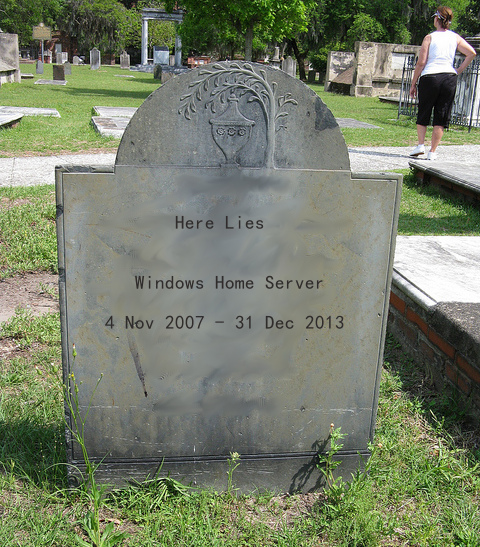
One Windows Server version that was close to many of our readers' hearts is Windows Home Server. This too is being left behind. The current version, Windows Home Server 2011, is the last ever version. It's not going to disappear overnight—it will be available for OEM preinstallations until an astonishing and not entirely plausible December 31, 2025, though hobbyist system builders only have until December 31, 2013 to buy standalone copies—but it won't receive any new features or upgrades.
Naturally, Windows Home Server's die-hard band of advocates is annoyed by this news.
Windows Home Server was always something of an odd fish, and it led a short and trouble-filled life. The idea was that you would have a server hidden away in a closet or under a desk somewhere, and it would provide a central place for storing backups, sharing media files, and remotely accessing your network.
WHS's killer feature was arguably something called Drive Extender. This allowed multiple hard drives to be pooled together to create large storage volumes. To protect against disk failures, Drive Extender would copy data to multiple disks, ensuring that if any one disk died, you'd retain your data.
The trick here was that Drive Extender was dynamic. If you were running low on disk space, just plug in a USB hard disk, and Drive Extender would do the rest. You'd have more storage space, and it would still take care of mirroring data to protect it for you. It made storage management simple. Instead of RAIDs, with their strict disk size requirements and static sizing, you could let the storage grow on an as-needed basis.
The Windows Home Server idea was tremendously popular among a small group of fans, but it never won much mainstream appeal.
Things took a turn for the worse with Windows Home Server 2011. The original Drive Extender was actually a crude hack that never really worked properly. It worked by copying files automatically between NTFS volumes. Sometimes it would copy files that hadn't been completely written yet, resulting in broken files and data loss. Even after these issues were ironed out—which took many months—Drive Extender could sometimes change file metadata.
Microsoft's plan was to produce a trio of new server products—Windows Home Server 2011, Small Business Server 2011 Essentials, and Windows Storage Server 2008 R2 Essentials—that would include a new, improved Drive Extender, one that didn't have the fragility of the original version. This new Drive Extender would work at a level below the file system, rather than merely copying files around on the file system, so would solve all the Drive Extender problems in one fell swoop.
Unfortunately, Microsoft couldn't get this new Drive Extender working in time, so decided to remove it from those three products entirely. Windows Home Server 2011 could still manage backups and remote access, but it no longer had the pooled storage that made it so convenient in the first place.
And now it turns out that sad and deficient version of the product will be its last.
So the home server dream is dead, and the nearest direct equivalent—Windows Server 2012 Essentials—costs substantially more ($425, compared to about $50).
This is upsetting for those who had bought in to the home server dream, but for everyone else, it's not such a disaster.
Two steps forward...
Microsoft never gave up on the Drive Extender-type technology. In fact, the company has now got it working, and it's an integrated part of both Windows 8 and Windows Server 2012: it's called storage spaces. We don't need a dedicated home server to have expandable redundant storage made of whatever disks are convenient; a Windows 8 desktop will do the job just fine.
Those Storage spaces make pretty good destinations for backups, too. Windows 8 has a new backup tool that provides periodic snapshots of your data, similar to Apple's Time Machine system. Now, I don't like everything about this new backup system, because Microsoft has used it as an opportunity to discard one of Windows' best little-known features, Shadow Copies, which also provided periodic snapshots, but overall it's a great solution for home networks. Point all your computers at a network location, and they'll automatically back themselves up, and they'll automatically keep those backups up-to-date.
Remote access to network files is nicely handled with the new and improved SkyDrive client. Not only can you directly place files into "the cloud" for remote access, you can also see non-cloud-synced files on any machine running the client (subsuming similar functionality from Microsoft's old Live Mesh client).
Local media streaming and sharing is now, for the most part, built-in to Windows and Xbox, with the "Play To" DLNA features that Microsoft introduced in Windows 7.
... one step back
This isn't to say that every feature from Windows Home Server has a neat replacement. If you want a more traditional backup system, you'll need to configure it all by hand. Windows Home Server worked as a Terminal Services gateway, simplifying remote desktop access to machines on your LAN; that's not found in Windows 8, so you'll have to come up with some other alternative.
But overall, most of what Windows Home Server did—and, I'd argue, all of the really useful stuff it did—is still possible, and still easy, without Windows Home Server. And when it comes to creating great big pools of redundant disk space that you can expand as and when you need to, Windows 8 does the job better than Windows Home Server could ever hope to.
Listing image by Travis S. / Megan Geuss
reader comments
113